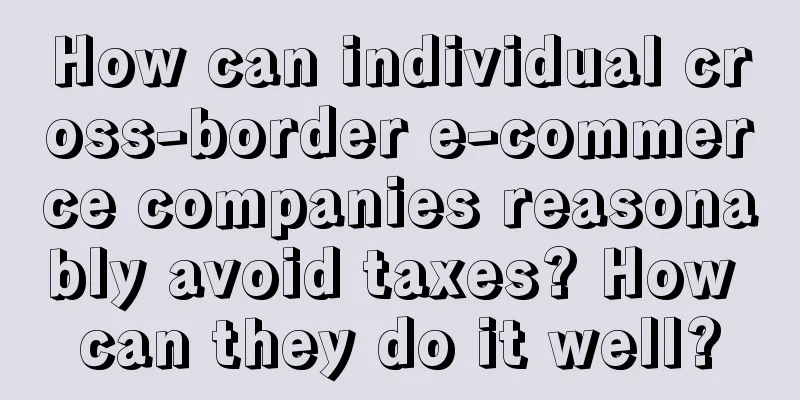How can individual cross-border e-commerce companies reasonably avoid taxes? How can they do it well?

|
Now there are more and more merchants doing cross-border e-commerce. For merchants, if they want to do cross-border e-commerce well, they must master some skills. So how can individual cross-border e-commerce reasonably avoid taxes? The following content will introduce it to you. How can individual cross-border e-commerce companies reasonably avoid taxes? Factors to consider when deciding whether to pay tax: 1. Is there a Nexus in the states where the seller and the consumer are located? Nexus means connection and relationship, which can be roughly divided into three situations: a. The seller has stores, employees, and inventory in a certain state b. Sellers ask websites and market organizations in the state to help them attract traffic c. The seller buys the goods from wholesalers in the state and asks them to ship the goods on his behalf If you are in any of the above three situations, then you need to pay sales tax; if you ship entirely from China, you don't have to pay tax. 2. Do the product categories sold need to pay taxes? Most products are subject to tax, but there are exceptions. For example, clothing in Pennsylvania does not need to be taxed. In this case, sellers need to understand the regulations of each state in the United States. Knowing the factors that determine whether or not you should pay taxes, you will know how to reasonably avoid taxes. Sellers can try their best to avoid having Nexus with the state where the consumer is located, or sell products that are not taxed by the state government, thereby exempting themselves from paying taxes. How to do it well? 1. Choose a platform: Amazon, AliExpress, eBay, Lazada, Shopee, etc. 2. Platform entry Each platform has detailed regulations for entry, and generally requires submission of corporate information and legal representative materials. Some platforms do not require corporate registration, and this is based on different rules for different platforms. For example, to enter eBay, you need a business license and legal person identity certificate, as well as company address proof (corporate public bills, public water, electricity, gas bills, telephone bills, etc.) and prepare sales information in advance (products, country, warehouse, etc.). Southeast Asian platforms such as Shopee and Lazada are a little simpler, requiring only a business license and other cross-border platform experience (store link + transaction screenshots). 3. User positioning User positioning is something that every e-commerce operator needs to consider. First, users should be divided into old users, similar users, and users with broad interests. Old users can then be divided into users who have made multiple purchases, users who have completed purchases, users who have added products to the shopping cart, and visitor users. It is best to make a table and perform data analysis to locate users for exclusive advertising. It is important to note that after completing user positioning, you can see who your core audience is. This type of audience is the primary target for sellers to place advertisements on social media. Sellers can understand the interests of this part of the audience through past sales and some audience analysis tools, and place advertisements based on these interests. The conversion rate of this part of the audience is the highest. 4. Product selection At this point, the most important thing is product selection. The first iron rule for product selection is: do not touch infringing products! Especially if the platform you choose is a platform with very strict management like Amazon, your account will be immediately blocked and your funds will be frozen. Secondly, the product selection is selected from several major wholesale platforms, such as 1688, wholesalers, Yiwu procurement, etc. are all good choices. When setting the price of a product, the costs that need to be considered include: product cost, shipping cost, packaging cost, platform cost, plus the profit you want to make, and the final sum is your product price. But one thing to note is that it is not recommended for novices to engage in price wars! 5. Store operation and management The operation of a store is very complicated. Not only do you need management and marketing thinking, but you also need the ability to position the market, diagnose the store, analyze data, layout products, control the overall situation, explore selling points, and develop marketing strategies. Of course, if you want to grow from a newbie to a giant, it is essential to personally experience the distribution process, and continuously put on shelves and improve listings. Good listings will bring more traffic and attract customers to place orders, and good sales services will bring more repeat customers. 6. Warehousing and logistics Regarding warehousing, I don’t think stockpiling inventory in advance is a good choice. New sellers generally have no accumulated experience. Indiscriminately hoarding goods will only lead to unsaleable goods later, resulting in product backlogs. Regarding logistics, sellers must clearly understand the logistics management of the platform you are on, its customs clearance, where the bonded warehouses and overseas warehouses are, and also, when choosing logistics, you must choose stable delivery time to keep customers waiting for a short time and ensure high satisfaction. 7. Select payment method This step is an extremely important link. We all know that the payment methods supported by each country and each platform are different, so you should think in advance whether the payment method of the platform you are entering is acceptable to you? Generally, the mainstream options are: Paypal, World First, Payoneer, Ping Pong, Lianlian and bank checks. For the specific payment methods of each platform, you can check it on its official website or ask customer service. After reading the above introduction, you should know how to do personal cross-border e-commerce. In fact, it is possible to avoid taxes reasonably. Merchants can go and learn about the relevant information. I hope the above content can solve your problems. Recommended reading: Which platform should I choose for cross-border e-commerce? What are the requirements for entry? How to do cross-border e-commerce for individuals? What do you need to prepare? Is cross-border e-commerce profitable for individuals? How can you make money? |
>>: What email addresses do cross-border e-commerce companies use? What are their characteristics?
Recommend
Sold out again! Why is Nokia doing this?
Why is Nokia out of stock amid fierce competition ...
Does Amazon Australia require VAT? What are the rules?
After learning about Amazon, we know that it has b...
How do Lazada buyers apply for returns? How to deal with malicious returns?
Nowadays, cross-border e-commerce is a business pa...
Starting a nationwide layout: the core competitiveness and membership store trend of fresh food supply chain company Fudi
Against the backdrop of increasingly fierce compet...
Stop updating for 3 years? No money? Those internet celebrities with millions of fans who "disappeared"...
This article introduces the Douyin bloggers who st...
Where is Lazada's local store suitable for opening? What are the advantages?
There are many merchants doing cross-border e-comm...
The full hosting model is sweeping cross-border e-commerce. Can the first batch of TikTok Shops make money?
As major cross-border e-commerce platforms have su...
When will the Shopee refund be credited to your account? Answers to questions about Shopee refunds
The Shopee cross-border e-commerce platform is sti...
WeChat's "Shake" app is offline: Zhang Xiaolong's masterpiece disappears without a trace
WeChat first added the "Shake" function ...
Super anchor's trust game
With the rise of the e-commerce industry, super an...
Letter to the boss: Category domination is the ultimate goal of Xiaohongshu's operation
The author of this article talks about how to occu...
How seductive is “anthropomorphic” copywriting?
Anthropomorphic advertising copy is no longer unco...
Which is better, being an Amazon Seller Elf or a Mango Store Manager? What are the operation skills?
In the daily operation of Amazon sellers, the choi...
Four major trends in event marketing in 2024
This article reviews the representative event mark...
How many sites does eBay have? Which one is easier to do business with?
Among cross-border e-commerce platforms, eBay is a...









